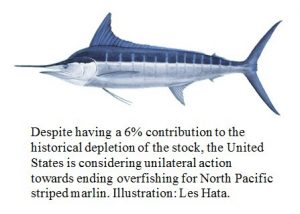 March 19, 2021 — HONOLULU — The following was released by the Western Pacific Fishery Management Council:
March 19, 2021 — HONOLULU — The following was released by the Western Pacific Fishery Management Council:
The SSC suggested several actions to end overfishing of North Pacific striped marlin in order to satisfy the Magnuson-Stevens Act (Section 304(i)) obligation both internationally via the Western and Central Pacific Fisheries Commission (WCPFC) and domestically. The Scientific and Statistical Committee (SSC) of the Western Pacific Regional Fishery Management Council made these and other recommendations during its three-day virtual meeting this week.
International recommendations included improving standardized reporting of billfish catch and discards for all WCPFC fisheries; using circle hooks in all WCPFC longline fisheries; limiting WCPFC member catches to approximately 1 million pounds (500 metric tons) per year; and supporting a consultative rebuilding plan.
A new stock assessment may be provided in 2022 and the SSC proposed that discard mortality (fish that don’t survive capture and release) be included within future rebuilding scenario analyses. The SSC also recommended that future rebuilding efforts utilize a phased-in approach over several years based on a target catch rate rather than a rebuilding timeline.
To support U.S. Pacific Territory data collection efforts, the SSC recommended the integration of creel survey, commercial receipt book, biosampling and app-based data collection systems, such as the Council’s Catchit Logit app, to generate the necessary data from different segments of the fisheries. The Council, territorial fishery management agencies and NMFS are working closely to meet the requirements for stock assessments and address deficiencies in data-limited or data-poor fisheries.
The SSC also recommended supporting an experimental study to evaluate the effectiveness of various mitigation combinations to reduce seabird interactions in the Hawaiʻi shallow-set longline fishery. Currently, if setting off the stern of the boat, conservation measures require the vessel to start setting its gear one hour after sunset (night-setting), use blue-dyed bait and strategic discharge of fish parts and spent bait.
Night-setting, while considered to be a “gold standard” for seabird mitigation, prevents shallow-set longline fishermen from adjusting their setting time according to the moon phase to optimize swordfish catch. Fishermen have expressed interest in testing out a new combination of mitigation measures, including tori (bird scaring) lines, to improve operational efficiency while ensuring impacts to seabirds remain low in the fishery.
Recommendations made by the SSC on these and other matters will be considered by the Council when it meets March 23-25, 2021, virtually with host sites at Tedi of Samoa Building, Suite 208B, Fagatogo Village, American Samoa; BRI Building, Suite 205, Kopa Di Oru St., Garapan, Saipan, Commonwealth of the Northern Mariana Islands (CNMI); and Cliff Pointe, 304 W. O’Brien Drive, Hagatña, Guam. On the first day, NMFS will give a briefing on President Biden’s Executive Order 14008 on Tackling the Climate Crisis at Home and Abroad.
Instructions on connecting to the web conference, agendas and briefing documents are posted at www.wpcouncil.org/meetings-calendars. Host sites are subject to local and federal safety and health guidelines regarding COVID-19; check the Council website for updates.
